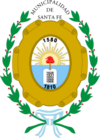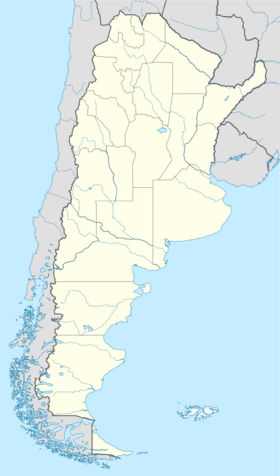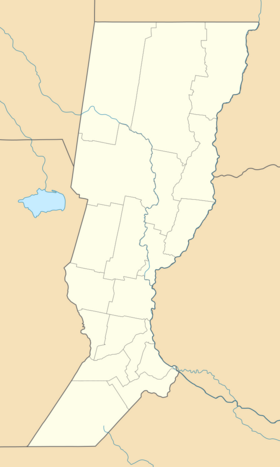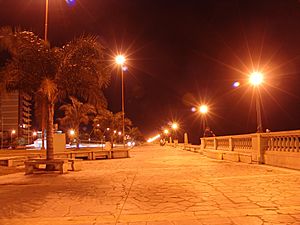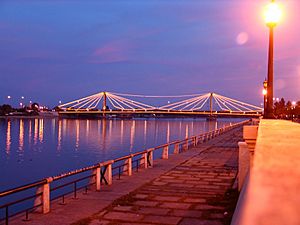Santa Fe, Argentina facts for kids
Quick facts for kids
Santa Fe de la Vera Cruz
|
||
|---|---|---|
|
City
|
||

Santa Fe, Argentina
|
||
|
||
| Country | ||
| Province | ||
| Department | La Capital | |
| Founded | 1573 | |
| Area | ||
| • City | 748 km2 (289 sq mi) | |
| Elevation | 25 m (82 ft) | |
| Population
(2010 census)
|
||
| • Urban | 391,164 | |
| • Metro | 653,073 | |
| Demonym(s) | Santafesino/a | |
| Time zone | UTC−3 (ART) | |
| CPA base |
S3000
|
|
| Dialing code | +54 342 | |
Santa Fe de la Vera Cruz is often called just Santa Fe. This name means "Holy Faith" in Spanish. It is the capital city of the Santa Fe province in Argentina. The city is located in northeastern Argentina. It sits where the Paraná and Salado rivers meet.
Santa Fe is about 15 kilometers (9 miles) from the Hernandarias Subfluvial Tunnel. This tunnel connects it to the city of Paraná. A canal also links Santa Fe to the port of Colastiné on the Paraná River. In 2010, Santa Fe de la Vera Cruz had about 391,164 people. Its larger metropolitan area had 653,073 people. This makes it the eighth largest city area in Argentina.
Santa Fe de la Vera Cruz is connected to Rosario by a major highway. Rosario is the largest city in the province. It is about 170 kilometers (106 miles) south. Córdoba is about 340 kilometers (211 miles) west. Santa Fe also has the Sauce Viejo Airport. This airport offers daily flights to Rosario and Buenos Aires.
Contents
History of Santa Fe
Founding and Early Years
Santa Fe de la Vera Cruz was first founded in 1573. It was built near a place called Cayastá. The Spanish explorer Juan de Garay started the settlement. He led an expedition from Asunción (which is now in Paraguay). Cayastá now has a historical park. You can find the grave of Hernandarias there. He was the first governor in South America born in the Americas.
The settlement moved to its current location in 1653. This was because the Cayastá River often flooded. In 1814, Santa Fe became the capital of the province. This happened when the province of Santa Fe separated from the province of Buenos Aires. The National Constituent Assembly met in Santa Fe in 1853.
Growth and Development
Santa Fe de la Vera Cruz grew into an important center. It became a hub for trade and transport. The area around it is rich in farms. They produce grains, vegetable oils, and meats. The city is also home to several universities. These include the National Technological University – Santa Fe Regional Faculty and the Catholic University of Santa Fe. The National University of the Littoral was first founded in 1889. It got its current name in 1919.
A suspension bridge was finished in 1924. Flooding badly damaged it in 1983. A second bridge, the Oroño, opened in 1971. The city still faces risks from flooding. On April 29, 2003, the Salado River rose almost 2 meters (6.5 feet). This happened in just a few hours after heavy rain. It caused a huge flood. Over 100,000 people had to leave their homes. Large parts of the city were underwater for more than a week.
In 2003, the suspension bridge was reopened. In 2008, the city's old grain silos became the Los Silos Hotel and Casino. San Martín Street was also changed to be only for people walking. Santa Fe has played a big role in Argentina's history. It hosted important meetings to write the Argentine Constitution in 1949, 1957, and 1994.
Climate and Weather
Understanding Santa Fe's Climate
Santa Fe has a humid subtropical climate. This means it has warm, wet summers and mild winters. Sometimes, winter temperatures can drop below 0°C (32°F) on very cold nights. Summers are usually hot and humid. During the hottest times, temperatures have gone above 45°C (113°F). Temperatures have even gone over 35°C (95°F) in every season.
Rainfall happens throughout the year. However, summer is usually the wettest season. Thunderstorms can be very strong. They often have lots of lightning, powerful winds, and heavy rain. The coldest temperature ever recorded was -7.0°C (19.4°F) on June 13, 1967. The hottest was 45.6°C (114.1°F) on January 25, 1986.
| Climate data for Santa Fe, SF (Sauce Viejo Airport) 1991–2020, extremes 1961–present | |||||||||||||
|---|---|---|---|---|---|---|---|---|---|---|---|---|---|
| Month | Jan | Feb | Mar | Apr | May | Jun | Jul | Aug | Sep | Oct | Nov | Dec | Year |
| Record high °C (°F) | 45.6 (114.1) |
40.9 (105.6) |
38.6 (101.5) |
36.5 (97.7) |
34.3 (93.7) |
30.9 (87.6) |
33.6 (92.5) |
38.6 (101.5) |
40.7 (105.3) |
41.0 (105.8) |
44.0 (111.2) |
42.9 (109.2) |
45.6 (114.1) |
| Mean daily maximum °C (°F) | 31.5 (88.7) |
30.0 (86.0) |
28.5 (83.3) |
24.6 (76.3) |
21.0 (69.8) |
18.0 (64.4) |
17.5 (63.5) |
20.3 (68.5) |
22.5 (72.5) |
25.2 (77.4) |
28.0 (82.4) |
30.2 (86.4) |
24.8 (76.6) |
| Daily mean °C (°F) | 25.7 (78.3) |
24.4 (75.9) |
22.6 (72.7) |
18.9 (66.0) |
15.5 (59.9) |
12.4 (54.3) |
11.5 (52.7) |
13.8 (56.8) |
16.3 (61.3) |
19.4 (66.9) |
22.2 (72.0) |
24.4 (75.9) |
18.9 (66.0) |
| Mean daily minimum °C (°F) | 20.1 (68.2) |
19.1 (66.4) |
17.6 (63.7) |
14.0 (57.2) |
11.0 (51.8) |
7.9 (46.2) |
6.7 (44.1) |
8.3 (46.9) |
10.6 (51.1) |
14.0 (57.2) |
16.5 (61.7) |
18.7 (65.7) |
13.7 (56.7) |
| Record low °C (°F) | 7.2 (45.0) |
6.2 (43.2) |
3.1 (37.6) |
0.2 (32.4) |
−5.0 (23.0) |
−7.0 (19.4) |
−6.6 (20.1) |
−5.0 (23.0) |
−2.9 (26.8) |
0.2 (32.4) |
3.9 (39.0) |
5.6 (42.1) |
−7.0 (19.4) |
| Average precipitation mm (inches) | 98.7 (3.89) |
117.5 (4.63) |
138.4 (5.45) |
127.9 (5.04) |
52.1 (2.05) |
33.3 (1.31) |
25.4 (1.00) |
32.2 (1.27) |
49.4 (1.94) |
114.8 (4.52) |
143.0 (5.63) |
143.1 (5.63) |
1,075.8 (42.35) |
| Average precipitation days (≥ 0.1 mm) | 7.0 | 7.3 | 7.1 | 8.0 | 5.0 | 3.5 | 3.2 | 3.5 | 5.4 | 7.9 | 7.7 | 8.3 | 73.9 |
| Average relative humidity (%) | 68.5 | 72.9 | 75.0 | 78.5 | 80.7 | 80.7 | 77.4 | 72.0 | 69.1 | 70.2 | 67.4 | 67.2 | 73.3 |
| Mean monthly sunshine hours | 288.3 | 240.1 | 241.8 | 195.0 | 176.7 | 150.0 | 179.8 | 210.8 | 210.0 | 235.6 | 267.0 | 266.6 | 2,661.7 |
| Mean daily sunshine hours | 9.3 | 8.5 | 7.8 | 6.5 | 5.7 | 5.0 | 5.8 | 6.8 | 7.0 | 7.6 | 8.9 | 8.6 | 7.3 |
| Percent possible sunshine | 63 | 64 | 55 | 53 | 50 | 44 | 46 | 54 | 47 | 55 | 58 | 54 | 54 |
| Source 1: Servicio Meteorológico Nacional | |||||||||||||
| Source 2: UNLP (percent sun 1971–1980) | |||||||||||||
Exploring the City
Santa Fe has worked to improve its areas for visitors. You can find riverside bars and fun nightclubs. There are also fancy restaurants. Major highways have been improved. The city also has a special underwater tunnel.
Transportation in Santa Fe
Railways and Stations
Santa Fe once had four railway stations. However, trains no longer serve the city for passengers. The Mitre Railway station closed in 2007. The Santa Fe Belgrano and Guadalupe stations stopped being used in 1993. This happened when train services across Argentina were privatized.
In recent years, the city government has updated some stations. The Santa Fe Belgrano station is now a convention center. The Guadalupe station was planned to be a stop for a new city train. However, that project did not happen. The oldest station, built in 1885, was torn down in 1962. A bus station was built in its place.
Sports in Santa Fe
Santa Fe is known for its sports. It was one of the host cities for the 1990 FIBA World Championship in basketball. The Estadio Ángel Malvicino hosted games for the 2002 FIVB Men's Volleyball World Championship. Santa Fe also held the first-ever Five-pin billiards World Championship in 1965.
The city has two major football teams. They are Club Atlético Colón and Club Atlético Unión. These teams play against each other in the exciting Santa Fe derby. Santa Fe is also the hometown of famous boxing figures. These include Amílcar Brusa, Carlos Baldomir, and Julio César Vásquez.
Notable People from Santa Fe
Many famous people were born in Santa Fe. They include athletes, artists, and writers.

- Ariel Ramírez, a famous musician and composer.
- Carlos Reutemann, a Formula One race car driver and former governor.
- Carlos Delfino, a professional basketball player.
- Leopoldo Luque, a football player who won the World Cup.
- Liliana Bodoc, a well-known writer.
- Osvaldo Bayer, a respected writer.
- Fernando Birri, a famous film maker.
- Mercedes Sosa, a beloved singer.
- Carlos Guastavino, a talented pianist and composer.
Sister Cities
Santa Fe has special connections with other cities around the world. These are called sister cities.
 Santa Fe Springs, United States (since 1960)
Santa Fe Springs, United States (since 1960) Ypacaraí, Paraguay (since 1978)
Ypacaraí, Paraguay (since 1978) Cuneo, Italy
Cuneo, Italy Montevideo, Uruguay
Montevideo, Uruguay
Images for kids
-
Santa Fe, Argentina
See also
 In Spanish: Santa Fe (Argentina) para niños
In Spanish: Santa Fe (Argentina) para niños


